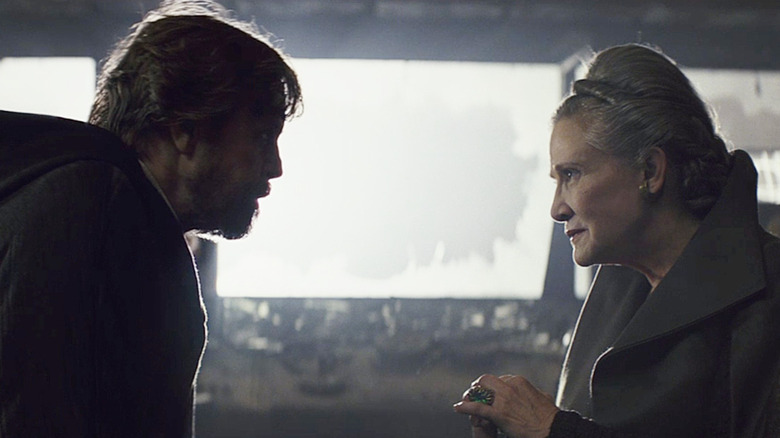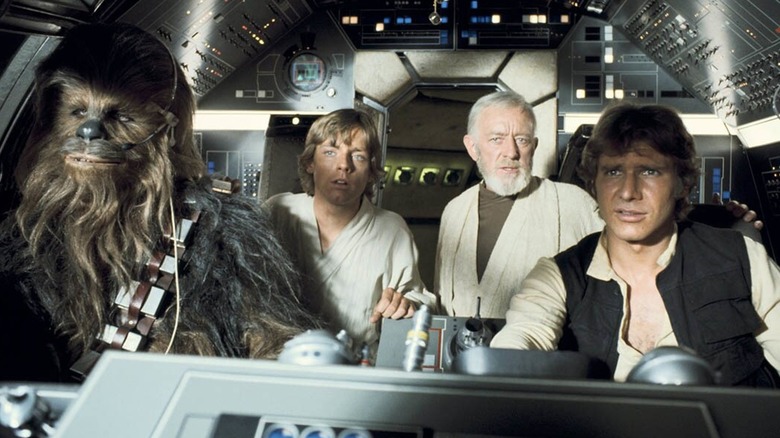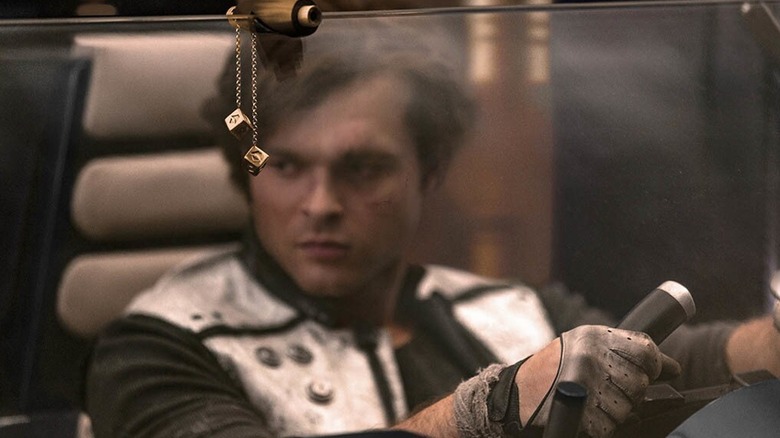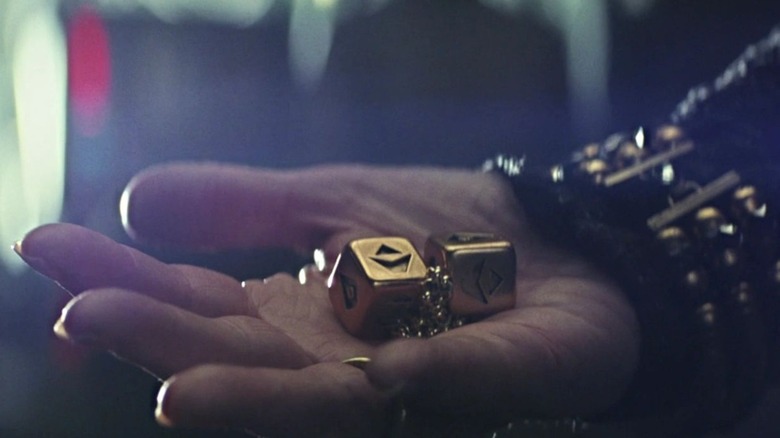Luke's Final Gift To Leia In Star Wars: The Last Jedi Explained
Moments before the climactic duel of 2017's "Star Wars: Episode VIII — The Last Jedi," Luke Skywalker (Mark Hamill) arrives in a cave that's holding the last vestiges of the Resistance. Their leader, his sister Leia (Carrie Fisher), is among them, and Luke gives her a gift that goes unexplained: a set of gold-plated dice with unique symbols on them. In a moment heavy with the weight of final farewells, this little grace note, as well as Luke's line that "no one's ever really gone," shines particularly bright.
Luke leaves Leia, sacrificing himself to give the Resistance enough time to flee the planet of Crait. His plan, to distract his villainous nephew (and Leia's son) Kylo Ren (Adam Driver), proves successful — a vast array of laser beams can't kill him, and neither can Kylo's lightsaber. As it turns out, this Luke isn't really there. He's been using the Force to "project" his body to the planet, while he meditates on Ahch-To. The dice, as Kylo Ren finds later when his army raids the cave, were a projection as well. They disappear in his hands, a reflection not just of his failures in that moment but of the moment he sealed his reputation as the major antagonist of the "Star Wars" sequel trilogy — his murder of his father Han Solo (Harrison Ford) in 2015's "Episode VII — The Force Awakens."
The dice belonged to Han Solo decades before, a slight decoration hanging on the ceiling of his ship, the Millennium Falcon. Luke giving them to Leia was effectively a posthumous tribute to the love of her life, Han. Still, for as touching as the scene is, the dice were a small detail from Han's past — small enough for their significance to not even register for most viewers.
A cool detail
When Han Solo's dice show up in 1977's "Star Wars" (or "Episode IV — A New Hope"), it seems like just one of a million little details to make that movie's world come to life. Given how much writer-director George Lucas was constantly reshaping the story of the film, it mostly strikes viewers as a little curiosity. Han's partner in crime might be a giant Wookiee named Chewbacca, and the movie might be teeming with all kinds of robots and bizarre alien life forms, but once Luke gets inside Han Solo's Millennium Falcon, the smuggler becomes, simply, a cool guy with a cool ship. And the dice carry that impression further.
As far as the original trilogy of "Star Wars" (from the 1977 film to 1983's "Episode VI — Return of the Jedi") goes, that's the only real appearance of the dice. In the context of that movie, they mostly just serve the purpose of translating some familiar Earth iconography to an alien landscape. The dice suggest that he's a gambler, in keeping with his association with crime as well as his outsized claims of selfishness. There's no need for any more detail than that — and you don't get any.
In fact, according to LucasFilm's Pablo Hidalgo (per StarWars.com), the only additional detail anybody got on Han's dice came from the Marvel Comics run of "Star Wars," issue #81, which ran in March of 1984. When Han is reunited with the Millennium Falcon in the comic, he notes that it still has the dice he "won her with."
How Han won the ship
When Han Solo is reunited with his old friend Lando Calrissian (Billy Dee Williams) in 1980's "Episode V — The Empire Strikes Back," Lando notes that the Millennium Falcon used to belong to him. By the end of the original trilogy, Han's backstory and in particular his relationship with the ship seems pretty well-established — as a young and desperate scoundrel he ended up winning a vessel well beyond his means in a card game. That same ship became the lifeblood of his criminal activity and, later, his heroic deeds.
Viewers didn't get to actually see Han winning the ship from Lando until 2018's "Solo: A Star Wars Story," Ron Howard's prequel film about Han as a young man (establishing, among many other things, how he was given the surname of "Solo"). While the movie performed well below expectations it did provide viewers with more answers as to Han's (here played by Alden Ehrenreich) origins, bringing back vintage "Star Wars" aesthetics in the context of a solid heist movie. And it also had Donald Glover doing a shockingly good Billy Dee Williams impression as young Lando.
Besides everything else, the movie also explains Han Solo's dice, a relic of his difficult childhood on the planet of Corellia. He gives them to love interest Q'ira (Emilia Clarke) before she leaves the planet, and gets them back in time to use them to beat Lando in a game of Sabacc, ultimately winning the Falcon in the process. From there, the dice became a good luck charm Han kept in the cockpit.
Rolling the dice
When Luke decides to give Leia the dice in "The Last Jedi," it is a tribute to Han, whose death in "The Force Awakens" raised the stakes of the sequel trilogy. For as much as the dice serve as a connective plot point in the movie, they're also meant to stoke a sentimental feeling in the viewer — even if you didn't know what the dice were for exactly, you could tell it meant a great deal to the characters, one of whom was walking toward certain death.
According to Madlyn Burkert, speaking to StarWars.com, the dice made for "The Last Jedi" were a little different from the dice used in either "A New Hope" or "The Force Awakens." Because "A New Hope" only ever featured the dice in a wide shot (where they were simply normal dice painted gold) and they didn't end up making the final cut of "The Force Awakens," these dice would need to be designed in a way that was true to the aesthetic of the series. The dice of "Jedi" were made of fabricated metal, and the even more detailed dice of "Solo" had their own unique design.
"The Last Jedi" was the first mainline series entry outside of the prequels without Han Solo, and the absence was felt. Luke's delivery of an iconic, albeit little-seen item associated with the character makes for a touching moment. For a movie that would end up dividing fans in many ways, it has a clear love for the series' iconography — even down to the dice in the Falcon's cockpit.



